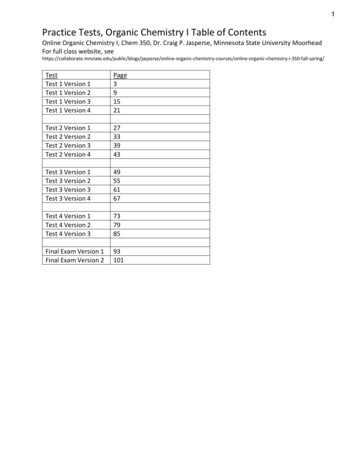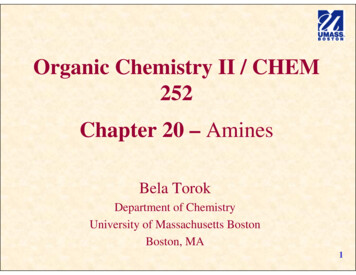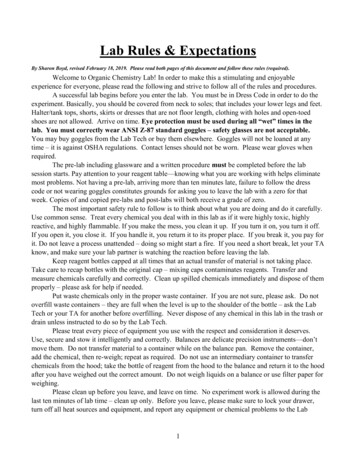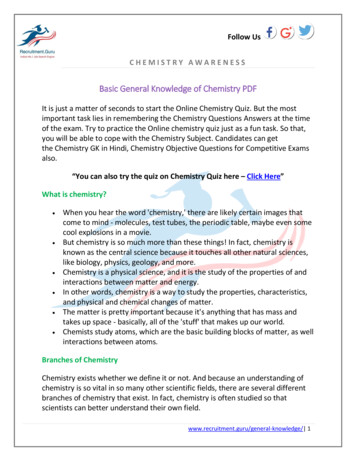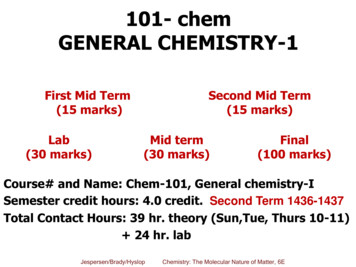
Transcription
101- chemGENERAL CHEMISTRY-1First Mid Term(15 marks)Lab(30 marks)Second Mid Term(15 marks)Mid term(30 marks)Final(100 marks)Course# and Name: Chem-101, General chemistry-ISemester credit hours: 4.0 credit. Second Term 1436-1437Total Contact Hours: 39 hr. theory (Sun,Tue, Thurs 10-11) 24 hr. labJespersen/Brady/HyslopChemistry: The Molecular Nature of Matter, 6E
101-ChemInstructor: Dr. Amal AL-MohaimeedOffice location: Blg. 5, T floor, Room No. 188Office hours: Sun, Tues, Thurs 9:00-10:00 Email address:muhemeed@ksu.edu.saTotal Contact Hours: 14 weeks x 3 hrs Theory(Sun, Tues, Thurs 10-11)14x 2 hrs Lab (Mon 10-12)Mid Term Exam: (First mid-term: Tues, 21/5, 12-1)(Second mid-term: Tues, 27/6,12-1)Jespersen/Brady/HyslopChemistry: The Molecular Nature of Matter, 6E
General Chemistry-1Book: Chemistry: The Molecular Nature of Matter, 6EJespersen/Brady/HyslopChapterSubject1Chapter 1: The Mole and Stoichiometry (7 hrs)2Chapter 2: Properties of Gases (6 hrs)3Chapter 3: Energy and Thermodynamics (7 hrs)4567Chapter 4: Chemical Kinetics (4 hrs)Chapter 5: Properties of Solutions (5 hrs)Chapter 6: Chemical Equilibrium (7 hrs)Chapter 7: Acids and Bases (3 hrs)Jespersen/Brady/HyslopChemistry: The Molecular Nature of Matter, 6E3
Chapter 1The Mole and StoichiometryChemistry: The Molecular Natureof Matter, 6EJespersen/Brady/Hyslop
International System of Units (SI) Standard system of units Metric Seven Base UnitsJespersen/Brady/HyslopChemistry: The Molecular Nature of Matter, 6E5
Your Turn!The SI unit of length is theA. millimeterB. meterC. yardD. centimeterE. footJespersen/Brady/HyslopChemistry: The Molecular Nature of Matter, 6E6
Decimal MultipliersJespersen/Brady/HyslopChemistry: The Molecular Nature of Matter, 6E7
Using Decimal Multipliers Use prefixes on SI base units when number istoo large or too small for convenient usage Numerical values of multipliers can beinterchanged with prefixesEx. 1 mL 10–3 L 1 km 1000 m 1 ng 10–9 g 1,130,000,000 s 1.13 109 s 1.13 GsJespersen/Brady/HyslopChemistry: The Molecular Nature of Matter, 6E8
Laboratory Measurements Four common1.2.3.4.Distance istry: The Molecular Nature of Matter, 6E9
Laboratory Measurements1.Distance (d) SI Unit is meter (m) Meter too large for most laboratorymeasurements Commonly use Centimeter (cm) 1 cm 10–2 m 0.01 m Millimeter (mm) 1 mm 10–3 m 0.001 mJespersen/Brady/HyslopChemistry: The Molecular Nature of Matter, 6E10
2. Volume (V) Dimensions of (dm)3 SI unit for Volume m3 Most laboratorymeasurements use V inliters (L) 1 L 1 dm3 (exactly) Chemistry glasswaremarked in L or mL 1 L 1000 mL What is a mL? 1 mL 1 cm3Jespersen/Brady/HyslopChemistry: The Molecular Nature of Matter, 6E11
3. Mass SI unit is kilogram (kg) Frequently use grams (g) in laboratory as morerealistic size 1 kg 1000 g11 g 0.1000 kg 1000 gJespersen/Brady/HyslopChemistry: The Molecular Nature of Matter, 6E12
4. TemperatureA. Celsius scale Most common for use in science Water freezes at 0 C Water boils at 100 C 100 degree units between melting and boilingpoints of waterJespersen/Brady/HyslopChemistry: The Molecular Nature of Matter, 6E13
4. TemperatureB. Kelvin scale SI unit of temperature is kelvin (K) Water freezes at 273.15 K and boils at 373.15 K 100 degree units between melting and boilingpointsAbsolute Zero Zero point on Kelvin scale 0 K - 273.15 CJespersen/Brady/HyslopChemistry: The Molecular Nature of Matter, 6E14
Temperature Conversions Must convert to Kelvin scaleT K (t C 273.15 C) 1K1 C Ex. What is the Kelvin temperature of a solutionat 25 C?T K (25 C 273.15 C) Jespersen/Brady/Hyslop1K1 C 298 KChemistry: The Molecular Nature of Matter, 6E15
Learning Check: T ConversionsEx. Convert 77 K to the Celsius scale.T K (t C 273.15 C) tC1KtC 1 C1 C (77 K 273.15K)1KJespersen/Brady/Hyslop1 C (T K 273.15K)1K –196 CChemistry: The Molecular Nature of Matter, 6E16
Table 2.2 Some Non-SI Metric Units CommonlyUsed in ChemistryJespersen/Brady/HyslopChemistry: The Molecular Nature of Matter, 6E17
Derived SI Units All physical quantities will have units derived fromthese seven SI base unitsEx. Area Derived from SI units based on definition of area length width area meter meter aream m m2 SI unit for area square meters m2Jespersen/Brady/HyslopChemistry: The Molecular Nature of Matter, 6E18
Densitymassdensity volumemd VUnits g/mL or g/cm3Jespersen/Brady/HyslopChemistry: The Molecular Nature of Matter, 6E19
Learning Check What is the SI unit for velocity?distanceVelocity (v) timemeters mVelocity units seconds s What is the SI unit for volume of a cube?Volume (V) length width heightV meter meter meterV m3Jespersen/Brady/HyslopChemistry: The Molecular Nature of Matter, 6E20
21Jespersen/Brady/HyslopChemistry: The Molecular Nature of Matter, 6E
StoichiometryStoichiometric Calculations Conversions from one set of units to anotherusing Dimensional Analysism n x MMN n x NAm: mass, n: amount (mol), MM: molar mass,N: number of particles, NA: Avogadro’s noJespersen/Brady/HyslopChemistry: The Molecular Nature of Matter, 6E22
The Mole Number of atoms in exactly 12 grams ofatoms12CEx. How many atoms in 1 mole of 12C ? Based on experimental evidence1 mole of 12C 6.022 1023 atoms 12.011 gAvogadro’s number NA 1 mole of X 6.022 1023 units of X Number of atoms, molecules or particles in onemole 1 mole Xe 6.022 1023 Xe atoms 1 mole NO2 6.022 1023 NO2 moleculesJespersen/Brady/HyslopChemistry: The Molecular Nature of Matter, 6E23
Moles of CompoundsAtoms Atomic Mass Mass of atom (from periodic table) 1 mole of atoms gram atomic mass 6.022 1023 atomsMolecules Molecular Mass Sum of atomic masses of all atoms incompound’s formula1 mole of molecule X gram molecular mass of X 6.022 1023 moleculesJespersen/Brady/HyslopChemistry: The Molecular Nature of Matter, 6E24
Moles of CompoundsIonic compounds Formula Mass Sum of atomic masses of all atoms in ioniccompound’s formula1 mole ionic compound X gram formula mass of X 6.022 1023 formula unitsGeneralMolar mass (MM) Mass of 1 mole of substance (element, molecule, orionic compound) under consideration1 mol of X gram molar mass of X 6.022 1023 formula unitsJespersen/Brady/HyslopChemistry: The Molecular Nature of Matter, 6E25
SI Unit for Amount Mole1 mole of substance X gram molar mass of X 1 mole S 32.06 g S 1 mole NO2 46.01 g NO2 Molar mass is our conversionfactor between g & moles 1 mole of X 6.022 1023 units of X NA is our conversion factorbetween moles & molecules 1 mole H2O 6.022 1023molecules H2O 1 mole NaCl 6.022 1023formula units NaClJespersen/Brady/HyslopChemistry: The Molecular Nature of Matter, 6E26
Learning Check: Using Molar MassEx. How many moles of iron (Fe) are in 15.34 gFe? What do we know?1 mol Fe 55.85 g Fe What do we want to determine?15.34 g Fe ? Mol FeStartEnd Set up ratio so that what you want is on top & whatyou start with is on the bottom 1 mol Fe 0.2747 mole Fe15.34 g Fe 55.85 g Fe Jespersen/Brady/HyslopChemistry: The Molecular Nature of Matter, 6E27
Learning Check: Using Molar MassEx. If we need 0.168 mole Ca3(PO4)2 for anexperiment, how many grams do we need toweigh out? Calculate MM of Ca3(PO4)23 mass Ca 3 40.08 g 120.24 g2 mass P 2 30.97 g 61.94 g8 mass O 8 16.00 g 128.00 g1 mole Ca3(PO4)2 310.18 g Ca3(PO4)2 What do we want to determine?0.168 g Ca3(PO4)2 ? Mol FeStartEndJespersen/Brady/HyslopChemistry: The Molecular Nature of Matter, 6E28
Learning Check: Using Molar Mass 310.18 g Ca 3 (PO4 ) 2 0.160 mol Ca 3 (PO4 ) 2 1 mol Ca 3 (PO4 ) 2 52.11 g Ca3(PO4)2Jespersen/Brady/HyslopChemistry: The Molecular Nature of Matter, 6E29
Your Turn!Ex. How many moles of CO2 are there in 10.0 g?A. 1.00 molB. 0.0227 molC. 4.401 molD. 44.01 molE. 0.227 moln m/MMMolar mass of CO21 12.01 g 12.01 g C2 16.00 g 32.00 g O1 mol CO2 44.01 g CO2 1 mol CO 2 10.0 g CO 2 44.01 g CO 2 0.227 mol CO2Jespersen/Brady/HyslopChemistry: The Molecular Nature of Matter, 6E30
Your Turn!Ex. How many grams of platinum (Pt) are in 0.475mole Pt?A. 195 gB. 0.0108 gC. 0.000513 gD. 0.00243 gE. 92.7 gMolar mass of Pt 195.08 g/mol 195.08 g Pt 0.475 mol Pt 1 mol Pt 92.7 g PtJespersen/Brady/HyslopChemistry: The Molecular Nature of Matter, 6E31
Ex. How many silver atoms are in a 85.0 g silverbracelet? What do we know?107.87 g Ag 1 mol Ag1 mol Ag 6.022 1023 Ag atoms What do we want to determine?85.0 g silver ? atoms silverg Ag mol Ag atoms Ag 1 mol Ag 6.022 1023 atoms Ag 85.0 g Ag 1 mol Ag 107.87g Ag 4.7 1023 Ag atomsJespersen/Brady/HyslopChemistry: The Molecular Nature of Matter, 6E32
Using Avogadro’s NumberEx. What is the mass, in grams, of one moleculeof octane, C8H18?Molecules octane mol octane g octane1. Calculate molar mass of octaneMass C 8 12.01 g 96.08 gMass H 18 1.008 g 18.14 g1 mol octane 114.22 g octane2. Convert 1 molecule of octane to grams1 mol octane 114.22 g octane 23 1 mol octane 6.022 10 molecules octane 1.897 10–22 g octaneJespersen/Brady/HyslopChemistry: The Molecular Nature of Matter, 6E33
Learning Check: Mole ConversionsEx. Calculate the number of formula units of Na2CO3in 1.29 moles of Na2CO3. 6.0223 1023 formula units Na2 CO 3 1.29 mol Na2 CO 3 1molNaCO23 7.77 1023 particles Na2CO3Ex. How many moles of Na2CO3 are there in 1.15 x105 formula units of Na2CO3 ? 1 mol Na2 CO 3 1.15 10 formula units Na2 CO 3 6.0223 1023 formula units Na CO 23 5 1.91 10–19 mol Na2CO3Jespersen/Brady/HyslopChemistry: The Molecular Nature of Matter, 6E34
Your Turn!Ex. How many atoms are in 1.00 x 10–9 g of U?Molar mass U 238.03 g/mole.A.B.C.D.E.6.024.202.533.952.54xxxxx 1.00 101014 atoms1011 atoms1012 atoms10–31 atoms1021 atoms 9 1 mol U 6.022 1023 atoms U g U 1 mol U 238.03 g U 2.53 x 1012 atoms UJespersen/Brady/HyslopChemistry: The Molecular Nature of Matter, 6E35
Your Turn!Ex. Calculate the mass in grams of FeCl3 in 1.53 1023 formula units. (molar mass 162.204 g/mol)A. 162.2 gB. 0.254 gC. 1.661 10–22 gD. 41.2 gE. 2.37 10–221.53 1023 162.2 g FeCl3 1molFeCl3 units FeCl3 23 6.022 10 units FeCl 1 mol FeCl3 3 41.2 g FeCl3Jespersen/Brady/HyslopChemistry: The Molecular Nature of Matter, 6E36
Mole-to-Mole Conversion FactorsIn H2O there are: 2 mol H 1 mol H2O 1 mol O 1 mol H2O 2 mol H 1 mol O on atomic scale 2 atom H 1 molecule H2O 1 atom O 1 molecule H2O 2 atom H 1 molecule OJespersen/Brady/HyslopChemistry: The Molecular Nature of Matter, 6E37
Stoichiometric EquivalenciesEx. N2O52 mol N 1 mol N2O55 mol O 1 mol N2O52 mol N 5 mol OJespersen/Brady/HyslopChemistry: The Molecular Nature of Matter, 6E38
Calculating the Amount of a Compound byAnalyzing One ElementEx. sample is found to contain 0.864 moles ofphosphorus P. How many moles of Ca3(PO4)2 arein that sample? What do we want to find?0.864 mol P ? mol Ca3(PO4)2 What do we know?2 mol P 1 mol Ca3(PO4)2 Solution 0.864 mol P 1 mol Ca3 (PO4 ) 2 2 mol P 0.432 mol Ca3(PO4)2Jespersen/Brady/Hyslop Chemistry: The Molecular Nature of Matter, 6E39
Your Turn!Ex. Calculate the number of moles of calcium in 2.53moles of Ca3(PO4)2A. 2.53 mol CaB. 0.432 mol CaC. 3.00 mol CaD. 7.59 mol CaE. 0.843 mol Ca2.53 moles of Ca3(PO4)2 ? mol Ca3 mol Ca 1 mol Ca3(PO4)2 3 mol Ca 2.53 mol Ca 3 (PO4 ) 2 1 mol Ca 3 (PO4 ) 2 7.59 mol CaJespersen/Brady/HyslopChemistry: The Molecular Nature of Matter, 6E40
Mass-to-Mass CalculationsEx. Chlorophyll, the green pigment in leaves, has theformula C55H72MgN4O5. If 0.0011 g of Mg is availableto a plant for chlorophyll synthesis, how many gramsof carbon will be required to completely use up themagnesium? Analysis0.0011 g Mg ? g C0.0011 g Mg mol Mg mol C g C Assembling the tools24.3050 g Mg 1 mol Mg1 mol Mg 55 mol C1 mol C 12.011 g CJespersen/Brady/HyslopChemistry: The Molecular Nature of Matter, 6E41
Ex. Mass-to-Mass Conversion1 mol Mg 24.3 g Mg1 mol C 12.0 g C0.0011 g Mg mol Mg mol C g C1 mol Mg 55 mol C 1 mol Mg 55 mol C 12.0 g C 0.0011g Mg 24.3 g Mg 1 mol Mg 1 mol C 0.030 g CJespersen/Brady/HyslopChemistry: The Molecular Nature of Matter, 6E42
Your Turn!Ex. How many g of iron are required to use up allof 25.6 g of oxygen atoms (O) to form Fe2O3?A. 59.6 gB. 29.8 gC. 89.4 gD. 134 gE. 52.4 gmass O mol O mol Fe mass Fe25.6 g O ? g Fe3 mol O 2 mol Fe 1 mol O 2 mol Fe 55.845 g Fe 25.6 g O 16.0 g O 3 mol O 1 mol Fe 59.6 g FeJespersen/Brady/HyslopChemistry: The Molecular Nature of Matter, 6E43
Percentage Composition Percentage composition tells us mass of eachelement in 100.00 g of substancePercentage by Mass: %mass of element% by mass of element 100%mass of sampleEx. Na2CO3 is 43.38% Na 11.33% C 45.29% O What is sum of % by mass?Jespersen/Brady/Hyslop100.00%Chemistry: The Molecular Nature of Matter, 6E44
Ex. Percent CompositionEx. A sample of a liquid with a massof 8.657 g was decomposed into itselements and gave 5.217 g ofcarbon, 0.9620 g of hydrogen, and2.478 g of oxygen. What is thepercentage composition of thiscompound?Jespersen/Brady/HyslopChemistry: The Molecular Nature of Matter, 6E45
Ex. % Composition of Compound gC 5.217 g CFor C: 100% 100% 60.26% C8.657 g g total 0.9620 g H gH 100% 11.11% H 100% For H: 8.657 g g total 2.478 g O gO 100% 28.62% O 100% For O: 8.657 g g total Sum of percentages: 99.99%Jespersen/Brady/HyslopChemistry: The Molecular Nature of Matter, 6E46
Your Turn!Ex. A sample was analyzed and found to contain0.1417 g nitrogen and 0.4045 g oxygen. What isthe percentage composition of this compound?1. Calculate total mass of sampleTotal sample mass 0.1417 g 0.4045 g 0.5462 g2. Calculate % Composition of N 0.1417 g N gN 100% 25.94% N 100% 0.5462 g g total 3. Calculate % Composition of O gO 0.4045 g O 100% 100% 74.06% O g total 0.5462 g Jespersen/Brady/HyslopChemistry: The Molecular Nature of Matter, 6E47
Ex. Using Percent CompositionAre the mass percentages 30.54% N & 69.46% Oconsistent with the formula N2O4?Procedure:1. Assume 1 mole of compound2. Subscripts tell how many moles of each elementare present 2 mol N &4 mol O3. Use molar masses of elements to determinemass of each element in 1 mole Molar Mass of N2O4 92.14 g N2O4 / 1 mol4. Calculate % by mass of each elementJespersen/Brady/HyslopChemistry: The Molecular Nature of Matter, 6E48
Ex. Using Percent Composition (cont)14.07 g N2 mol N 28.14 g N1 mol N16.00 g O4 mol O 64.00 g O1 mol O28.14 g N%N 100% 30.54% N in N2O492.14 g N2 O 464.00 g O%O 100% 69.46% N in N2O492.14 g N2 O 4 The experimental values match the theoreticalpercentages for the formula N2O4.Jespersen/Brady/HyslopChemistry: The Molecular Nature of Matter, 6E49
Your TurnEx. If a sample containing only phosphorous &oxygen has percent composition 56.34% P &43.66% O, is this P4O10? 4 mol P 1 mol P4O1010 mol O 1 mol P4O10A. Yes4 mol P 4 30.97 g/mol P 123.9 g PB. No10 mol O 10 16.00 g/mol O 160.0 g O1 mol P4O10 283.9 g P4O10123.9g P%P 100% 43.64 % P283.9g P4 O10160.0g O%O 100% 56.36 % O283.9g P4 O10Jespersen/Brady/HyslopChemistry: The Molecular Nature of Matter, 6E50
Determining Empirical & MolecularFormulas When making or isolating new compounds onemust characterize them to determine structure &Molecular Formula Exact composition of one molecule Exact whole # ratio of atoms of each element inmoleculeEmpirical Formula Simplest ratio of atoms of each element incompound Obtained from experimental analysis of compoundCH2Oglucose Empirical formulaMolecular formulaC6H12O6Jespersen/Brady/HyslopChemistry: The Molecular Nature of Matter, 6E51
Strategy for DeterminingEmpirical Formulas1. Determine mass in g of each element2. Convert mass in g to moles3. Divide all quantities by smallest number ofmoles to get smallest ratio of moles4. Convert any non-integers into integer numbers. If number ends in decimal equivalent of fraction,multiply all quantities by least commondenominator Otherwise, round numbers to nearest integersJespersen/Brady/HyslopChemistry: The Molecular Nature of Matter, 6E52
1. Empirical Formula from Mass DataEx. When a 0.1156 g sample of a compound wasanalyzed, it was found to contain 0.04470 g of C,0.01875 g of H, and 0.05215 g of N. Calculate theempirical formula of this compound.Step 1: Calculate moles of each substance1 mol C0.04470 g C 3.722 10 3 mol C12.011 g C1 mol H0.01875 g H 1.860 10 2 mol H1.008 g H1 mol N0.05215 g N 3.723 10 3 mol N14.0067 g NJespersen/Brady/HyslopChemistry: The Molecular Nature of Matter, 6E53
1. Empirical Formula from Mass DataStep 2: Select the smallest # of moles. Lowest is 3.722 x 10–3 moleMole ratio3.722 10 3 mol C 1.000 C 33.722 10 mol C1.860 10 2 mol H 4.997 H 33.722 10 mol CInteger ratio 1 53.723 10 3 mol N 1 1.000 N 33.722 10 mol CStep 3: Divide all # of moles by the smallest oneEmpirical formula CH5NJespersen/Brady/HyslopChemistry: The Molecular Nature of Matter, 6E54
Empirical Formula from Mass CompositionEx. One of the compounds of iron Fe and oxygen O,When a 2.448 g sample was analyzed it was found tohave 1.771 g of Fe and 0.677 g of O. Calculate theempirical formula of this compound.Assembling the tools:1 mol Fe 55.845 g Fe1 mol O 16.00 g O1. Calculate moles of each substance1 mol Fe1.771 g Fe 0.03171 mol Fe55.485 g Fe1 mol O0.677 g O 0.0423 mol O16.00 g OJespersen/Brady/HyslopChemistry: The Molecular Nature of Matter, 6E55
1. Empirical Formula from Mass Data2. Divide both by smallest #mol to get smallestwhole # ratio.0.03171mol Fe 1.000 Fe 3 3.000 Fe0.03171mol Fe0.0423mol O 1.33 O 3 3.99 O0.03171mol FeOrFe 0.03171 O0.031710.04230.03171 Fe1.00O1.33Fe (1.00 3) O(1.33 3) Fe 3O3.99Empirical Formula Fe3O4Jespersen/Brady/HyslopChemistry: The Molecular Nature of Matter, 6E56
2. Empirical Formula from % CompositionEx. Calculate the empirical formula of a compoundwhose % composition data is 43.64 % P and 56.36 %O. If the molar mass is determined to be 283.9 g/mol,what is the molecular formula?Step 1: Assume 100 g of compound. 43.64 g P1 mol P 30.97 g 56.36 g O1 mol O 16.00 g1 mol P43.64 g P 1.409 mol P30.97 g P1 mol O56.36 g O 3.523 mol P16.00 g OJespersen/Brady/HyslopChemistry: The Molecular Nature of Matter, 6E57
2. Empirical Formula from % CompositionStep 2: Divide by smallest number of moles1.409 mol P 1.000 2 21.409 mol P3.523 mol O 2.500 2 51.409 mol PStep 3: Multiple by n to get smallest integer ratioHere n 2Empirical formula P2O5Jespersen/Brady/HyslopChemistry: The Molecular Nature of Matter, 6E58
Determining Molecular Formula Need molecular mass & empirical formula Calculate ratio of molecular mass to mass predictedby empirical formula & round to nearest integermolecular massn empirical formula massEx. GlucoseMolecular mass is 180.16 g/molEmpirical formula CH2OEmpirical formula mass 30.03 g/mol180.16 gn 630.03 gMolecular formula C6H12O6Jespersen/Brady/HyslopChemistry: The Molecular Nature of Matter, 6E59
Learning CheckThe empirical formula of a compound is P2O5. If themolar mass is determined to be 283.9 g/mol, what isthe molecular formula?Step 1: Calculate empirical massempirical mass P2 O5 2 mass P 5 mass O 2 30.97 g/mol 5 16.00 g/mol 61.94 80.00 g/mol 141.94 g/mol P2 O5Step 2: Calculate ratio of molecular to empirical mass283.9 g / moln 2Molecular formula P4O10141.94 g/molJespersen/Brady/HyslopChemistry: The Molecular Nature of Matter, 6E60
Your Turn!Ex.The empirical formula of hydrazine is NH2, andits molecular mass is 32.0. What is its molecularformula?Molar mass of NH2 A. NH2(1 14.01)g (2 1.008)g 16.017gB. N2H4C. N3H6D. N4H8n (32.0/16.02) 2E. N1.5H3Atomic 99Chemistry: The Molecular Nature of Matter, 6E61
Learning Check: Balancing EquationsunbalancedAgNO3(aq) Na3PO4(aq) Ag3PO4(s) NaNO3(aq) balanced3AgNO3(aq) Na3PO4(aq) Ag3PO4(s) 3NaNO3(aq)unbalancedZn(s) HCl(aq) ZnCl2(aq) H2(g)BalancedZn(s) 2HCl(aq) ZnCl2(aq) H2(g)Jespersen/Brady/HyslopChemistry: The Molecular Nature of Matter, 6E62
Balance by InspectionC3H8(g) O2(g) CO2(g) H2O(ℓ)Assume 1 in front of C3H83C1C 38H2H 41C3H8(g) O2(g) 3CO2(g) 4H2O(ℓ)2O 5 10O (3 2) 4 10H 2 4 88H1C3H8(g) 5O2(g) 3CO2(g) 4H2O(ℓ)Jespersen/Brady/HyslopChemistry: The Molecular Nature of Matter, 6E63
Your Turn!Ex. Balance each of the following equations.What are the coefficients in front of each compound?1 Ba(OH)2(aq) 1 Na2SO4(aq) 1 BaSO4(s) 2 NaOH(aq)223 O 2(g)KClOs) 3(s) KCl(2 3PO4(aq) 3 Ba(OH)2(aq) Ba1 3(PO4)2(s) H6 2O(ℓ)HJespersen/Brady/HyslopChemistry: The Molecular Nature of Matter, 6E64
Stoichiometric Ratios Consider the reactionN2 3H2 2NH3 Could be read as:“When 1 molecule of nitrogen reacts with 3molecules of hydrogen, 2 molecules of ammoniaare formed.” Molecular relationships 1 molecule N2 2 molecule NH3 3 molecule H2 2 molecule NH3 1 molecule N2 3 molecule H2Jespersen/Brady/HyslopChemistry: The Molecular Nature of Matter, 6E65
Stoichiometric Ratios Consider the reactionN2 3H2 2NH3 Could also be read as:“When 1 mole of nitrogen reacts with 3 moles ofhydrogen, 2 moles of ammonia are formed.” Molar relationships 1 mole N2 2 mole NH3 3 mole H2 2 mole NH3 1 mole N2 3 mole H2Jespersen/Brady/HyslopChemistry: The Molecular Nature of Matter, 6E66
Using Stoichiometric RatiosEx. For the reaction N2 3 H2 2NH3, howmany moles of N2 are used when 2.3 moles ofNH3 are produced? Assembling the tools 2 moles NH3 1 mole N2 2.3 mole NH3 ? moles N2 1 mol N2 1.2 mol N22.3 mol NH3 2 mol NH3 Jespersen/Brady/HyslopChemistry: The Molecular Nature of Matter, 6E67
Your Turn!Ex. If 0.575 mole of CO2 is produced by thecombustion of propane, C3H8, how many moles ofoxygen are consumed?C3H8(g) 5O2(g) 3CO2(g) 4H2O(g)A. 0.575 moleB. 2.88 moleC. 0.192 moleD. 0.958 moleAssembling the tools 0.575 mole CO2 ? moles O2 3 moles CO2 5 mole O2E. 0.345 mole 5 mol O2 0.958 mol O20.575 mol CO2 3 mol CO 2 Jespersen/Brady/HyslopChemistry: The Molecular Nature of Matter, 6E68
Using Balanced Equation toDetermine StoichiometryEx. What mass of O2 will react with 96.1 g of propane(C3H8) gas, to form gaseous carbon dioxide &water?Strategy1. Write the balanced equationC3H8(g) 5O2(g) 3CO2(g) 4H2O(g)2. Assemble the tools96.1 g C3H8 moles C3H8 moles O2 g O21 mol C3H8 44.1 g C3H81 mol O2 32.00 g O21 mol C3H8 5 mol O2Jespersen/Brady/HyslopChemistry: The Molecular Nature of Matter, 6E69
Using Balanced Equation toDetermine StoichiometryEx. What mass of O2 will react with 96.1 g ofpropane in a complete combustion?C3H8(g) 5O2(g) 3CO2(g) 4H2O(g)3. Assemble conversions so units cancel correctly1 mol C 3H85 mol O 232.0 g O 296.1 g C 3H8 44.1 g C 3H8 1 mol C 3H8 1 mol O 2 349 g of O2 are neededJespersen/Brady/HyslopChemistry: The Molecular Nature of Matter, 6E70
Your Turn!Ex. How many grams of Al2O3 are produced when41.5 g Al react?2Al(s) Fe2O3(s) Al2O3(s) 2Fe(ℓ)A. 78.4 gB. 157 gC. 314 gD. 22.0 gE. 11.0 g 1 mol Al 1 mol Al2 O 3 101.96 g Al2 O 3 41.5 g Al 26.98 g Al 2 mol Al 1 mol Al2 O 3 78.4 g Al2O3Jespersen/Brady/HyslopChemistry: The Molecular Nature of Matter, 6E71
Limiting Reactant Reactant that is completely used up in thereaction Present in lower # of moles It determines the amount of product produced For this reaction ethyleneExcess reactant Reactant that has some amount left over at end Present in higher # of moles For this reaction waterJespersen/Brady/HyslopChemistry: The Molecular Nature of Matter, 6E72
Ex. Limiting Reactant CalculationHow many grams of NO can form when 30.0 g NH3and 40.0 g O2 react according to:4 NH3 5 O2 4 NO 6 H2OSolution: Step 1mass NH3 mole NH3 mole O2 mass O2Assembling the tools 1 mol NH3 17.03 g 1 mol O2 32.00 gOnly have 40.0 g O2,O2 limiting reactant 4 mol NH3 5 mol O21 mol NH35 mol O 232.00 g O 230.0 g NH3 17.03gNH3 4 mol NH31 mol O 2 70.5 g O2 neededJespersen/Brady/HyslopChemistry: The Molecular Nature of Matter, 6E73
Ex. Limiting Reactant CalculationHow many grams of NO can form when 30.0 g NH3and 40.0 g O2 react according to:4 NH3 5 O2 4 NO 6 H2OSolution: Step 2mass O2 mole O2 mole NO mass NOAssembling the toolsCan only form 30.0 g NO. 1 mol O2 32.00 g 1 mol NO 30.01 g 5 mol O2 4 mol NO1 mol O 24 mol NO 30.01 g NO40.0 g O 2 32.00 g O 2 5 mol O 21 mol NO 30.0 g NO formedJespersen/Brady/HyslopChemistry: The Molecular Nature of Matter, 6E74
Your Turn!Ex. If 18.1 g NH3 is reacted with 90.4 g CuO, what isthe maximum amount of Cu metal that can beformed?2NH3(g) 3CuO(s) N2(g) 3Cu(s) 3H2O(g)(MM)(17.03)(79.55)(28.01)(64.55) (18.02)1 mol NH33 mol CuO 79.55 g CuO(g/mol)18.1 g NH3 17.03 g NH3A. 127 gB. 103 gC. 72.2 gD. 108 gE. 56.5 g2 mol NH31mol CuO127 g CuO needed.Only have 90.4g so CuO limiting90.4 g CuO 1 mol CuO3 mol Cu 63.546 g Cu 79.55 g CuO 3 mol CuO1mol Cu72.2 g Cu can be formedJespersen/Brady/HyslopChemistry: The Molecular Nature of Matter, 6E75
Theoretical vs. Actual Yield Theoretical Yield Maximum amount of product that must be obtainedif no losses occur. Amount of product formed if all of limiting reagent isconsumed. Actual Yield Amount of product that is actually isolated at end ofreaction. Amount obtained experimentally How much is obtained in mass units or in moles.Jespersen/Brady/HyslopChemistry: The Molecular Nature of Matter, 6E76
Percentage YieldUseful to calculate % yield.Percent yield Relates the actual yield to the theoretical yield It is calculated as: actual yield 100percentage yield theoretical yield Ex. If a cookie recipe predicts a yield of 36 cookiesand yet only 24 are obtained, what is the %yield? 24 percentageyield 100 67% 36 Jespersen/Brady/HyslopChemistry: The Molecular Nature of Matter, 6E77
Ex. Percentage Yield CalculationWhen 18.1 g NH3 and 90.4 g CuO are reacted, thetheoretical yield is 72.2 g Cu. The actual yield is58.3 g Cu. What is the percent yield?2NH3(g) 3CuO(s) N2(g) 3Cu(s) 3H2O(g)58.3 g Cu% yield 100% 80.7%72.2 g CuJespersen/Brady/HyslopChemistry: The Molecular Nature of Matter, 6E78
Learning Check: Percentage YieldEx. A chemist set up a synthesis of solid phosphorustrichloride PCl3 by mixing 12.0 g of solid phosphoruswith 35.0 g chlorine gas and obtained 42.4 g of solidphosphorus trichloride. Calculate the percentage yieldof this compound.Analysis:Write balanced equationP(s) Cl2(g) ldChemistry: The Molecular Nature of Matter, 6E79
Learning Check: Percentage YieldAssembling the Tools: 1 mol P 30.97 g P 1 mol Cl2 70.90 g Cl2 3 mol Cl2 2 mol PSolution1. Determine Limiting Reactant3 mol Cl2 70.90 g Cl21 mol P12.0 g P 41.2 g Cl230.97 g P2 mol P1 mol Cl2 But you only have 35.0 g Cl2, so Cl2 is limitingreactantJespersen/Brady/HyslopChemistry: The Molecular Nature of Matter, 6E80
Learning Check: Percentage YieldSolution2. Determine Theoretical Yield2 mol PCl3 137.32 g PCl31 mol Cl235.0 g Cl2 70.90 g Cl2 3 mol Cl21 mol PCl3 45.2 g PCl33. Determine Percentage Yield Actual yield 42.4 g 42.2 g PCl3 100 93.8 %percentageyield 45.2 g PCl3 Jespersen/Brady/HyslopChemistry: The Molecular Nature of Matter, 6E81
Your Turn!Ex. When 6.40 g of CH3OH was mixed with 10.2 g ofO2 and ignited, 6.12 g of CO2 was obtained. What wasthe percentage yield of CO2?2CH3OH 3O2 2CO2 4H2OMM(g/mol) (32.04) (32.00)(44.01) (18.02)A. 6.12%1 mol CH3 OH3 mol CO 232.00 g O 26.40 g CH3 OH 32.04 g CH3 OH 2 mol CH3 OH 1 mol O 2B. 8.79% 9.59 g O2 needed; CH3OH limitingC. 100%1 mol CH3 OH2 mol CO 244.01 g CO 26.40gCHOH D. 142%332.04 g CH3 OH 2 mol CH3 OH 1 mol CO 2E. 69.6% 8.79 g CO in theory26.12 g CH3 OH actual 100% 69.6%8.79 g CH3 OH theoryJespersen/Brady/HyslopChemistry: The Molecular Nature of Matter, 6E82
Molarity Concentration Number of moles of solute per liter of solution. Allows us to express relationship between molesof solute and volume of solution Hence, 0.100M solution of NaCl contains 0.100mole NaCl in 1.00 liter of solution Same concentration results if you dissolve 0.0100mol of NaCl in 0.100 liter of solutionmoles of solutemoleMolarity (M) liters of solution Volume0.100 mol NaCl0.0100mol NaCl 0.100M NaCl1.00 L NaCl soln 0.100 L NaCl solnJespersen/Brady/HyslopChemistry: The Molecular Nature of Matter, 6E83
Learning Check: Calculating Molarity(from grams and volume)Ex. Calculate the molarity (M) of a solutionprepared by dissolving 11.5 g NaOH (40.00 g/mol)solid in enough water to make 1.50 L of solution.g NaOH mol NaOH M NaOH1 mol NaOH11.5 g NaOH 0.288 mol NaOH40.00 g NaOHmoles NaOH 0.288 mol NaOHM L so ln1.50 L soln 0.192M NaOHJespersen/Brady/HyslopChemistry: The Molecular Nature of Matter, 6E84
Learning Check: Calculating Volume(from Molarity and moles)Ex. How many mL of 0.250 M NaCl solution areneeded to obtain 0.100 mol of NaCl? Use M de
Jespersen/Brady/Hyslop Chemistry: The Molecular Nature of Matter, 6E 101- chem GENERAL CHEMISTRY-1 Course# and Name: Chem-101, General chemistry-I Semester credit hours: 4.0 credit. Second Term 1436-1437 Total Contact Hours: 39 hr. theory (Sun,Tue, Thurs 10-11) 24 hr. l
